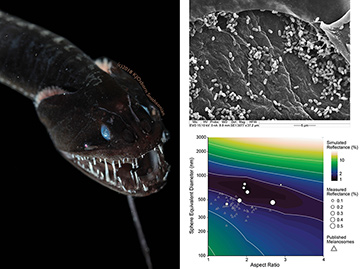 Left: Pacific blackdragon (Idiacanthus antrostomus) caught in Monterey Bay, CA, USA. Top right: TEM image of melanosome nanoparticles in skin of I. antrostomus. Bottom right: FDTD numerical modeling suggested that melanosome size and geometries in ultra-black deep-sea fishes (white circles) were well optimized to minimize reflectance relative to those of other vertebrate species (gray triangles). [Enlarge figure]
Left: Pacific blackdragon (Idiacanthus antrostomus) caught in Monterey Bay, CA, USA. Top right: TEM image of melanosome nanoparticles in skin of I. antrostomus. Bottom right: FDTD numerical modeling suggested that melanosome size and geometries in ultra-black deep-sea fishes (white circles) were well optimized to minimize reflectance relative to those of other vertebrate species (gray triangles). [Enlarge figure]
Ultra-black materials—those reflecting less than 0.5% of the light that hits them—can be used in telescopes, cameras and optical equipment to absorb stray light before it reaches the detector, or to improve light capture of absorbers such as solar panels. Many of these incredibly black materials, which can reflect as few as one in every thousand photons, are made from dense forests of vertically aligned carbon nanotubes,1 whose susceptibility to physical damage limits their potential applications.
Recently, several ultra-black animals have been discovered, ranging from birds to butterflies.2,3 Because the structures creating ultra-black coloration in such animals must withstand wear and tear during the animal’s life, they offer potential inspiration for more robust ultra-black materials. This year, our group reported that a simple pigment-packing mechanism has likely evolved multiple times to produce ultra-black skin in deep-sea fishes.4
Deep-sea fishes are among the blackest animals on the planet, and are the first known aquatic ultra-black animal. The evolutionary approach leading to their skin coloration overcomes the hydrophobicity seen in most ultra-black materials. The skin of these fishes contains ellipsoidal melanosomes—melanin-containing organelles—that are randomly packed in a continuous layer. As light strikes the melanosome layer, individual melanosomes scatter light within the layer where it has another chance to be absorbed, rather than reflecting it back toward the light source.
Using finite-difference time-domain modeling, we showed that the melanosomes in ultra-black fishes are optimized in size and shape to minimize reflectance. Melanosomes in ultra-black fishes are larger and more oblong than those found in other fishes, and our modeling predicts that this difference in shape reduces reflectance by more than 50%. We believe that this ultra-black skin camouflages the fishes from bioluminescence against a pitch-black deep-sea backdrop.
Like other ultra-black materials, both natural and human-made, those in these fishes rely on two processes: absorption and scattering. In birds and butterflies, scattering comes from keratin or chitin nanostructures, and absorption comes from melanin embedded within those matrices. In fishes, however, scattering and absorption both come from the same component: the melanosomes. From a biomimetic perspective, this simpler design eliminates the need to make carefully controlled nanostructures. Random close-packed nanoparticles of the right size and shape offer a potential solution for creating robust, easy-to-manufacture ultra-black materials.
Researchers
Alexander L. Davis, Kate N. Thomas, Freya E. Goetz and Sönke Johnsen, Duke University, Durham, NC, USA
Bruce H. Robison, Monterey Bay Aquarium Research Institute, Moss Landing, CA, USA
Karen J. Osborn, Smithsonian Institution, Washington, DC, USA
References
1. K. Mizuno et al. Proc. Natl. Acad. Sci. U.S.A. 106, 15 (2009).
2. D.E. McCoy et al. Nat. Commun. 9, 1 (2018).
3. A.L. Davis et al. Nat. Commun. 11, 1 (2020).
4. A.L. Davis et al. Curr. Biol. 30, 3470 (2020).
